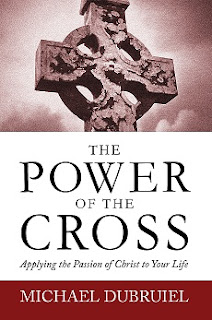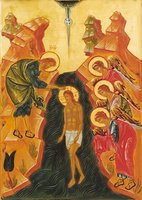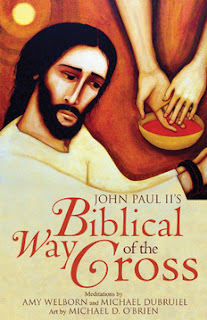The Cross of Christ Teaches Us. . . How to Pray
In the days of his flesh, Jesus offered up prayers and supplications, with loud cries and tears to him who was able to save him from death, and he was heard for his godly fear. HEBREWS 5:7
And in praying do not heap up empty phrases as the Gentiles do; for they think that they will be heard for their many words. Do not be like them, for your Father knows what you need before you ask him. MATTHEW 6:7–8
While visiting the Holy Spirit Trappist monastery in Conyers, Georgia, I wandered into the abbey church one afternoon to spend a few moments in prayer. A young woman with two small children was already there. Although she prayed inaudibly as her two small children circled about her, I could tell by her raised hands and her tears that she was pleading and reasoning with God. I have no idea what the woman was praying about, only that she was praying the way Moses is described in the Letter to the Hebrews, “. . .seeing him who is invisible.”
As the Israelites battled the Amalekites (see Exodus 17), Moses lifted his hands in prayer, holding his wooden staff over his head as the battle raged in the valley below. So long as Moses’ hands remained in the air, the Israelites were victorious; as Moses' arms grew tired and began to fall to his sides, the battle turned to the enemy’s advantage. When they realized what was happening, Aaron and Hur stood on either side of Moses, holding his hands aloft, until the battle was won.
To the early church fathers, the prayer of Moses in the battle with the Amalekites foreshadowed the victory Christ won on the cross. Like Aaron and Hur, we have an opportunity to stand with Christ, interceding for the salvation of souls. Of course, Moses, Aaron, and Hur had an advantage that we do not: They could see the effects of Moses’ intercession on the battle raging below. How our prayer life would change if God gave us the ability to see the effect our intercessions—or lack thereof—have on the battle that is being waged daily for souls.
The letter to the Hebrews draws a strong connection between the cross and prayer. Because every moment of our earthly existence is threatened by death, and we know neither the day nor the hour when that existence will come to an end, we, too, need to cry out to the God who can save us. Like Moses, we need the help of our fellow Christians to hold up our arms when they grow tired. We, too, need the help of the Holy Spirit to make up for what is lacking in our prayer.
Praying as a Follower of Christ
Throughout the centuries, Christians in the East and the West have signed themselves with the cross. When it is done with little thought or care, the sign loses much of its power. Contemplating both the action and what it symbolizes as you make the sign, on the other hand, is the perfect way to begin any conversation with God.
As you make the sign of the cross, you place your entire being in the shadow of the cross of Christ. By invoking the Trinity as you make this holy sign, you immediately call to mind that facing the cross is something we dare not do alone, but only in God’s presence. Every moment, we must choose between the way of the cross of Christ and the way of perdition. Every minute, the battle for our salvation is being lost or won.
“Do not pray like the Gentiles,” Jesus instructed his disciples. Some Christians see this as a prohibition of repetitive prayers, but clearly this isn’t what Jesus was condemning. The admonition had scarcely fallen from his lips when he proceeded to teach his disciples one of the most beloved prayers of all time: the “Our Father,” or “Lord’s Prayer.” Not only did Jesus teach his disciples to pray using a certain form; in the gospels we read that Jesus himself prayed the same words over and over in the Garden of Gethsemane, “He went away and prayed for the third time, saying the same words,” (Matthew 26:44).
When we share in Christ’s Passion we will often find ourselves able only to mouth the same words over and over. The early disciples of Jesus, those most familiar with his teachings on prayer, developed litanies and other repetitive prayers. For example, the “Lord Have Mercy” litany has remained in the liturgies of the East and West to this day, and is drawn from several gospel accounts, most notably the two blind men in Jericho who voiced this prayer repeatedly in desperation to Jesus, and who voiced it all the louder when the crowd tried to rebuke them (see Matthew 20:29–31).
Similarly, the Jesus Prayer (“Lord Jesus, Son of God, have mercy on me, a sinner”) is taken from the story of a blind man in Luke’s Gospel (see Luke 18:38). In the early church, Christians prayed with their bodies as well as their minds. Congregants often prayed with their hands outstretched in the “orans” position, lifting their minds and hearts to God as well as identifying with the crucified Christ. There have been attempts to restore this practice within the church; others choose to pray this way in private. In this way not only do we imitate the cross of Christ, we acknowledge that all of our prayer is through Christ and in Christ. It is also a good way to express one’s abandonment to God’s will. As our arms tire, we remember that our strength cannot save us; we need help both from God above and from our neighbors below.
So what are the “empty phrases” of the Gentiles that Jesus condemned? He objected to the mindless offering of prayers without faith. While times of “spiritual dryness” are a normal part of the Christian experience, we must guard against “going through the motions” for the benefit of others, and persevere with faith and trust.
In times of doubt, we must strive to embrace the cross of Christ in our lives. Refuse to give in to the passions, or to be held captive by sin. The way of the cross is the way of healing. As Father Benedict Groeschel rightly points out, the only thing that Jesus promised his disciples in this life was persecution. Yet many of us get caught up with the “cares of this world” and forget about the cross we are to carry as followers of Christ. May the cross with which we sign ourselves, and the cross we place before our eyes, always keep us mindful of what we are doing and what is at stake.
The Power of the Cross by Michael Dubruiel is a book well-suited to daily reading during Lent. The book is available here in pdf version. Daily excerpts will be reprinted in this space during Lent.











